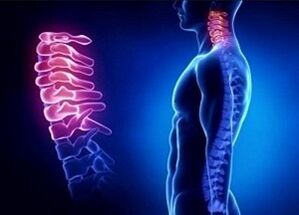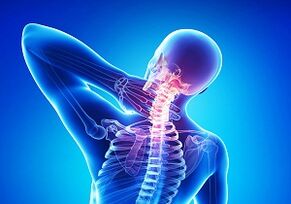
Osteochondrosis of the 2nd degree of the cervical region of the supporting pillar is a pathology that people of different ages face.Many ignore the symptoms of the initial phase of the disease, degenerative and dystrophic processes proceed more actively, pain appears.
Doctors advise paying attention to signs of osteochondrosis in the cervical zone.Do not wait until the cartilage between the disks is destroyed, which will doom the patient into constant pain, violation of the mobility of the neck.It is important to know: with a severe degree of discogenic pathology, brain hypoxia develops, dangerous cerebral disorders appear, and the risk of ischemic stroke increases.
General information
The first degree of the disease proceeds almost asymptomatic: sometimes weak pain in the neck appears, with palpation you can feel a slight muscle tension.If you start treatment in time: gymnastics, intake of analgesics, chondroprotectors, vitamins, massage, then it is enough just to stop the beginning process of degeneration.
In the absence of adequate treatment, the disease progresses.The second degree of cervical osteochondrosis of the spine is often detected by doctors in patients with complaints of headaches, unpleasant sensations when tilting and turns of the head, constraint of movements, tension of the muscles of the neck and shoulders.
Important points at 2 degrees of osteochondrosis in the cervical region:
- a crack of the fibrous ring appears, the instability of the cervical spine develops;
- Criminations in the process of diffusion, which ensures the full nutrition of the intervertebral discs, adversely affect the condition of cartilage tissue, the destruction of an important element begins.Violation of the structure of the amortization laying leads to a decrease in the height of the disk, the vertebrae approach each other, the movements of the head and neck cause pain;
- The pressure on the nerve roots increases, periodic pains appear.They can be eliminated with analgesics, but unpleasant sensations quickly return after the expiration of the drug;
- In the second stage of the disease, there is no active compression of the vertebral artery, but patients feel other signs of pathology: lethargy, sleep disturbance, increased fatigue, decrease in the level of performance;
- With cervical osteochondrosis, the pain is localized not only in the problem area, but also spreads to the back of the head, the upper back, shoulders.The progression of the disease against the background of impaired innervation of the adjacent departments causes cerebral complications;
- In the absence of treatment, maintaining the action of negative factors, the pathology goes to 3 degree with active damage to the fibrous ring and hyalin laying.The investigation is protrusions and intervertebral hernias, constant pain during the friction of the vertebrae, problems with the mobility of the cervical zone, and brightly exposed neurological disorders.
The reasons for the development of pathology
Osteochondrosis in the cervical region develops against the background of the following factors:
- hypothermia;
- violation of posture;
- Calcium deficiency and vitamins;
- the habit of sitting, hunched over, bowing his head low;
- long work at the computer;
- genetic predisposition;
- cervical injuries;
- Excessive load on the zone of the neck, too active head movements;
- improper mineral metabolism for the background of various pathologies;
- endocrine diseases;
- In the process of performing professional duties, the head is often thrown back.
Osteochondrosis of the 2nd degree of the cervical department code according to ICD - 10 m42.
Symptoms of cervical osteochondrosis

The progression of osteochondrosis of the neck indicates an increase in the pain syndrome, a deterioration in well -being, unpleasant sensations in the upper back, especially after stress or prolonged stay in one position.The closer the vertebrae of each other move, the more actively sag the ligaments, muscle strain appears to maintain the optimal position of the supporting pillar.
Subluxation vertebrae in combination with a decrease in the influence of the muscle frame enhances discomfort in the affected area.The displacement of an elastic laying provokes increased pain during turning, bending and extension of the neck.
The protrusion of the disk changes the correct position of neighboring bone structures, a violation of posture appears.If you do not start treatment, continue the uncontrolled intake of painkillers, then you can soon encounter negative symptoms of 3 degrees of cervical osteochondrosis.
Diagnostics
The treatment is carried out by a vertebrologist.You can also contact a neurologist.
To make a diagnosis, the profile specialist clarifies the clinical picture and an anamnesis, prescribes an X -ray of the cervical department and MRI.With severe muscle spasm, electromyography is needed, if the patient complains of pronounced cerebral disorders, then the dopplerography of the vessels will be needed.
Note!After the diagnosis, doctors often note that the patient develops a third degree of disease, but the active progression of the process can still be recognized using instrumental studies.If you urgently do not start treatment, then the symptoms of compression of the vertebral artery, followed by impaired cerebral circulation, the development of hypoxia of an important organ, will soon appear in full force.
Effective areas of therapy
After diagnosis, the doctor recommends eliminating the factors against which the disease progresses.If degeneratively stopped - dystrophic changes in the cartilage, then soon the pathological process will affect the bone structures and blood vessels, a set of negative features will appear.With a severe degree of pathology, it is difficult to stop the process of destruction of the cartilage, damage to the fibrous ring, doctors reveal the protrusion and hernia of the discs.
Medicines
The doctor selects several groups of drugs:
- Chondroprotectors.The compositions stop the destruction of the hyalin gasket, activate the process of regeneration of cartilage tissue.The course is from 3 months.
- NSAID.Eliminate inflammation in nerve roots, reduce pain and swelling, improve the mobility of the problem area.Drug forms: transdermal plasters, capsules, suspensions, tablets, gels, ointments.
- Musorelaxants.They help with painful muscle spasm, facilitate movement, relax muscle fibers.
- B vitamins.Neurotropic substances are indispensable for the restoration of the transmission of nerve impulses when pinching sensitive structures against the background of the progression of osteochondrosis.
- Analgesics.With headaches, discomfort against the background of muscle tension, damage to the intervertebral discs, ordinary analgesics should be taken.It is necessary to remember: painkillers only reduce discomfort, but without the treatment of osteochondrosis, unpleasant sensations in the cervical zone, shoulders, headaches, cerebral disorders will intensify as orthopedic pathology progresses.
- Sedatives.Sleep disturbance, headaches, discomfort in the movements of the head negatively affect the condition of the nervous system.Patients become irritable, insomnia appears more often.Plant compounds and synthetic drugs help: desert tincture, soothing phytosbor, valerian in tablets and tincture based on roots, mint decoction, lemon balm.
The corticosteroids and drug blockade of the spine in 2 degree of discogenic pathology in most cases are not needed: dystrophic and degenerative processes in intervertebral discs, adjacent tissues are not so active as to provoke painful pain.To facilitate the condition of the complex of these drugs.It is impossible to use powerful analgesics without prescribing a doctor: with 2 degrees of disease, there are enough preparations of moderate effects of exposure.
Other treatment methods
The patient should remember: exclusively with drugs it is impossible to stop the progression of cervical osteochondrosis.Complex therapy is a prerequisite for restoring the structure of depreciation laying, reducing pain, eliminating muscle spasm, and normalizing the mobility of the neck.
Effective methods:
- neck massage, including point;
- the use of the Lyapko and the Many -olest Ipplitor Kuznetsov;
- hirudotherapy;
- acupuncture;
- Physiotherapy: ozokeritic applications, mudlet, UHF, electrical and phonorophoresis with effective analgesic and anti-inflammatory drugs;
- physiotherapy exercises and special exercises for cervical osteochondrosis;
- manual therapy;
- Wearing a Shants collar.
Possible complications
Without timely, complex therapy, osteochondrosis progresses, brain dysfunctions appear against the background of compression of the vertebral artery, pinched nerve roots.The longer the patient puts off the visit to a neurologist or a vertebrologist, the more actively the intervertebral discs are destroyed, the risk of severe cerebral disorders increases.

The progression of cervical osteochondrosis often provokes various pathologies and dangerous conditions:
- dizziness for cervical osteochondrosis in combination with nausea and fainting;
- ischemic stroke;
- Scoliotic changes;
- the development of a low -oriented cone on the neck, which is popularly called the "widow of the hump";
- Pain syndrome in the zone of the neck, nape.Discomfort is enhanced by changing weather conditions, head movement;
- jumps in blood pressure;
- protrusion and a more dangerous form of pathology with a rupture of a fibrous ring, bright pain syndrome - hernia of the intervertebral disc;
- severe headaches, including migraine -like nature;
- Numbness of the cervical region, shoulders, unpleasant tingling, pain and decrease in the sensitivity of the hands.
For the prevention of cervical osteochondrosis, preventing the transition of pathology to a more severe 3 degree, the patient must perform a doctor’s prescription, take drugs, do gymnastics for the neck, attend massage sessions, influence the problem area using a transdermal patch.It is important to abandon smoking, eat right, do not hunch, more often change the position of the head during the working day, but avoid sudden movements.The unwillingness to be treated, irregularity of procedures, reduction in the course of chondroprotectors, frequent stress, hypothermia, hypodynamia are factors that enhance the risk of progression of cervical osteochondrosis.



















